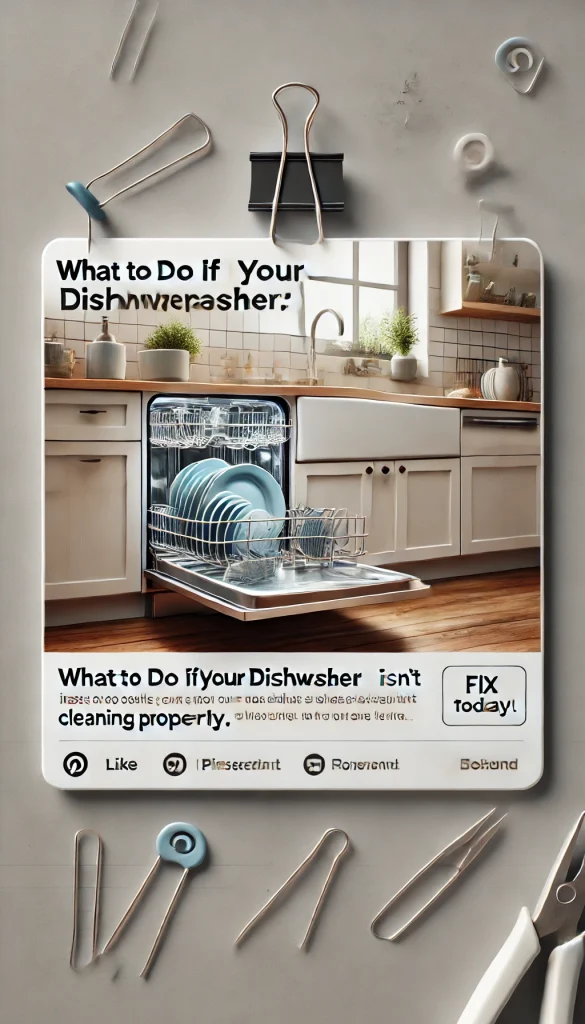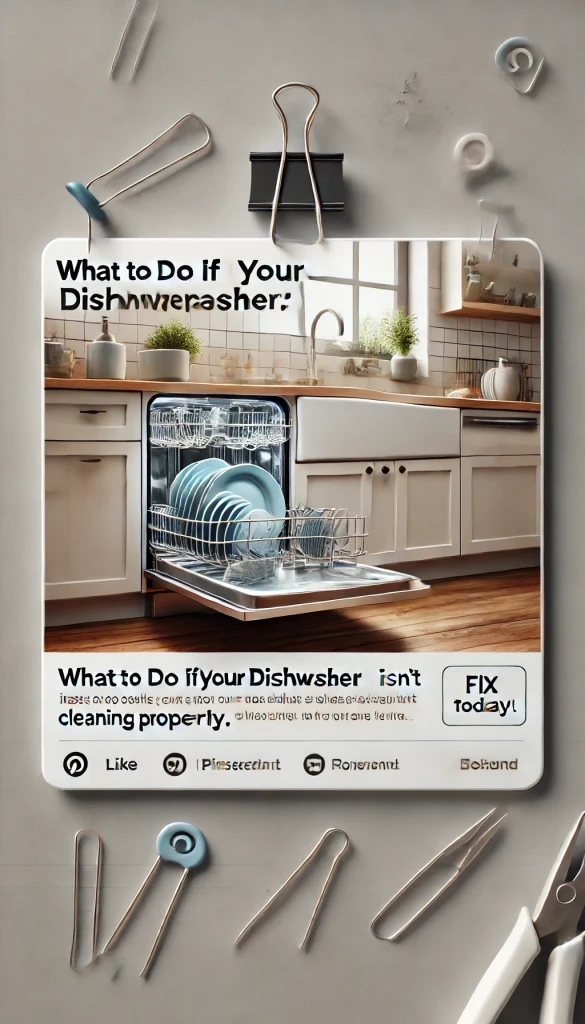Let’s set the scene: you open your dishwasher expecting sparkling clean dishes, only to find a smudge-covered glass and a fork with last night’s spaghetti sauce clinging to it. Frustrating, right? Don’t worry, you’re not alone. A dishwasher that isn’t cleaning properly is a common annoyance, but it’s usually fixable without calling in the pros. So, what’s going wrong, and how can you get your dishwasher back in tip-top shape? Let’s dive in!

Why Isn’t Your Dishwasher Cleaning Properly?
First things first—what’s causing the issue? A dishwasher is like a mini cleaning robot, but even robots have their quirks. Here are some common culprits:
- Clogged Spray Arms
The spray arms are the stars of the show, shooting water at high pressure to clean your dishes. If they’re clogged with food particles or mineral deposits, they can’t do their job. - Dirty Filter
Dishwashers have filters to catch food debris, but if the filter is full or clogged, water can’t flow properly. - Hard Water Build-Up
If you live in an area with hard water, mineral deposits can accumulate inside your dishwasher, reducing its effectiveness. - Improper Loading
Let’s be honest—have you ever just crammed dishes in without a second thought? Overloading or placing items incorrectly can block water flow. - Low Water Temperature
Hot water is essential for breaking down grease and grime. If your water isn’t hot enough, your dishwasher can’t clean effectively.
Key takeaway: Identifying the problem is the first step to finding a solution. Does one of these issues sound familiar? Let’s move on to fixing it.
Next: Simple fixes to try before calling in the pros.
Easy Fixes for a Dishwasher That Isn’t Cleaning
Now that we know what might be causing the problem, let’s roll up our sleeves and fix it. These simple steps can make a world of difference:
1. Clean the Spray Arms
- Remove the spray arms and inspect them for blockages.
- Use a toothpick or a small brush to clean out any debris from the holes.
- Rinse them thoroughly before reinstalling.
2. Check and Clean the Filter
- Locate the filter (usually at the bottom of the dishwasher).
- Remove it and rinse under warm water. Use a soft brush to scrub away any stubborn residue.
- A clean filter ensures proper water flow and helps avoid unpleasant odors.
3. Run a Cleaning Cycle
- Pour a cup of white vinegar into a dishwasher-safe bowl and place it on the top rack.
- Run a hot water cycle to remove grease and grime.
- For extra sparkle, sprinkle baking soda on the bottom of the dishwasher and run a short cycle.
4. Adjust Your Loading Technique
- Make sure plates, bowls, and utensils aren’t blocking the spray arms.
- Avoid overloading—leave enough space for water to reach every dish.
5. Test the Water Temperature
- Run your kitchen faucet until the water is hot before starting the dishwasher.
- For optimal cleaning, water should be at least 120°F (49°C).
Pro tip: If hard water is a recurring issue, consider using a dishwasher cleaner or installing a water softener.
Next: What to do if these fixes don’t solve the problem.
When the Basics Don’t Work
If you’ve tried the easy fixes and your dishwasher still isn’t cleaning properly, it might be time for a deeper dive. Here are a few advanced troubleshooting tips:
1. Inspect the Water Inlet Valve
- The water inlet valve controls the flow of water into the dishwasher. If it’s faulty or clogged, your dishwasher might not be getting enough water.
2. Check the Circulation Pump
- The pump is responsible for moving water through the spray arms. If it’s not working, water won’t reach your dishes effectively.
3. Examine the Detergent Dispenser
- Make sure the dispenser is opening properly during the cycle. If not, your detergent might not be doing its job.
4. Call a Professional
- If all else fails, it might be time to call in an expert. Persistent issues could be a sign of a more serious problem that requires professional repair.
Next: Tips to prevent dishwasher problems in the future.
Preventing Future Dishwasher Issues
Want to keep your dishwasher running like new? Here are some tips for long-term maintenance:
- Clean Regularly:
- Wipe down the door seals and edges to prevent grime buildup.
- Run a cleaning cycle with vinegar or a dishwasher cleaner once a month.
- Use the Right Detergent:
- Make sure you’re using high-quality detergent that’s compatible with your water type.
- Rinse Large Debris:
- While modern dishwashers can handle small bits of food, scraping off large chunks can prevent clogs.
- Check Spray Arms and Filters:
- Periodically inspect and clean these parts to keep them functioning properly.
- Avoid Overloading:
- Give your dishes some breathing room to ensure they all get cleaned.
Key takeaway: A little maintenance goes a long way in avoiding frustrating dishwasher issues.
Conclusion: Say Goodbye to Dirty Dishes
There’s nothing worse than a dishwasher that doesn’t do its job, but with these tips, you’ll have it back in working order in no time. From simple fixes like cleaning the spray arms to advanced troubleshooting, there’s a solution for just about every issue. Try out these tips and see the difference they make. And remember—regular maintenance can save you from future headaches. Happy dishwashing!

